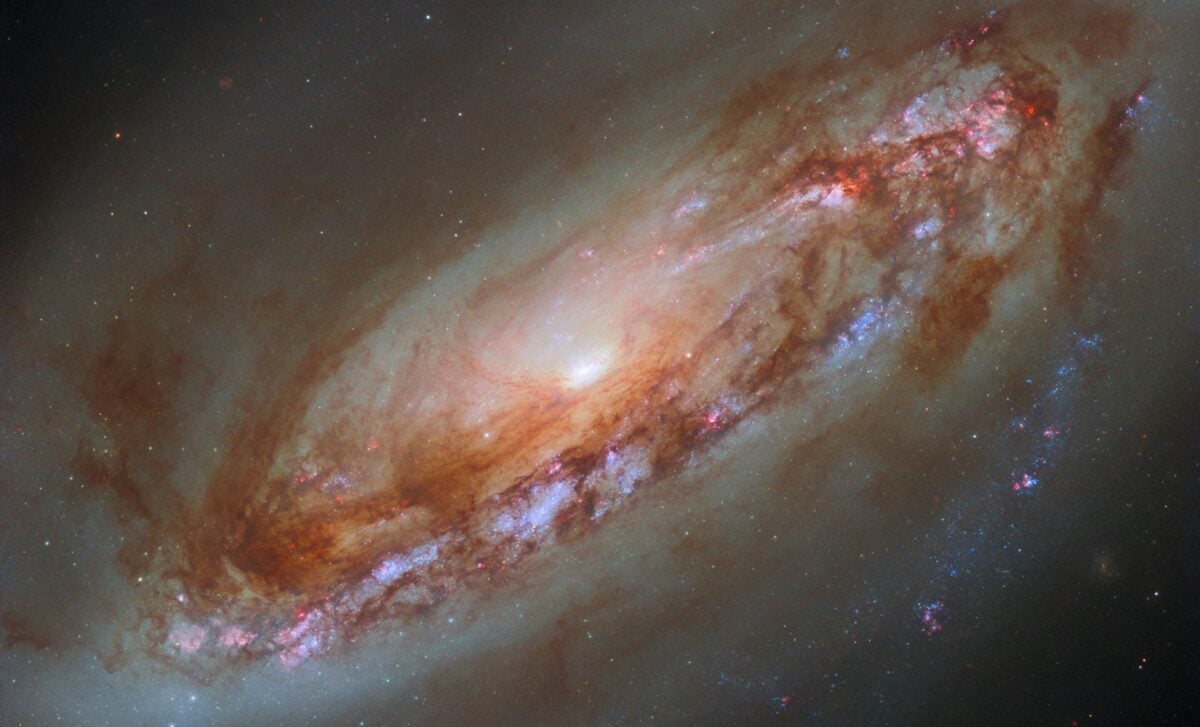The Hubble Space Telescope has captured a stunning new image of Messier 90 (M90), a spiral galaxy located 55 million light-years away in the Virgo constellation. Uniquely, M90 is one of the few galaxies moving toward Earth, propelled by its journey through the Virgo Cluster. The image showcases intricate details, including the galaxy’s bright core, dusty disk, and gaseous halo, providing fresh insight into its evolution as it continues to lose the gas necessary for star formation.
Hubble Captures Breathtaking Image of M90, a Galaxy Speeding Toward Earth

The Hubble Space Telescope has unveiled a striking new image of Messier 90 (M90), a stunning spiral galaxy in the Virgo constellation that is moving closer to Earth. Situated approximately 55 million light-years away, M90 is part of the Virgo Cluster, a collection of galaxies that is relatively near our own. What makes M90 exceptional is that it is one of the rare galaxies that is actively moving toward Earth, rather than away from it like most galaxies.
Unveiling M90: Hubble's Technological Prowess
The latest image, captured using Hubble’s Wide Field Camera 3 (WFC3), reveals unparalleled details about M90’s structure. The image showcases the galaxy’s bright core, dusty disk, and a diffuse gaseous halo, features that were less visible in previous images taken with older instruments.
This new view provides a more complete picture of M90’s complex environment, highlighting regions where star formation is still occurring, seen in the reddish H-alpha light emitted from nebulae in its disk. However, star formation is largely absent elsewhere in the galaxy due to the loss of its gas.
Hubble’s previous image of M90, taken in 1994 with the Wide Field and Planetary Camera 2 (WFPC2), had a characteristic stair-step pattern caused by the layout of its sensors. The advanced technology of the WFC3, installed in 2010, allows for a far more refined image, offering deeper insights into the galaxy’s current state and future evolution.
M90's Unique Motion toward Earth
M90 is currently undergoing a dramatic transformation. As it orbits through the Virgo Cluster, it has encountered dense gas near the cluster’s center. This gas has acted like a headwind, stripping M90 of the materials necessary to form new stars and creating the faint gaseous halo seen around the galaxy. Without this gas, M90 will slowly fade as a spiral galaxy, eventually evolving into a lenticular galaxy over the next few billion years.
Unlike most galaxies, which are receding from Earth due to the expansion of the universe, M90’s motion is propelling it toward us. Astronomers believe this acceleration is due to the galaxy's past interaction with the center of the Virgo Cluster. As M90 continues its trajectory, it is now in the process of escaping the cluster, and over the course of billions of years, it will draw closer to the Milky Way, offering an even more detailed view of this evolving galaxy.
A Galaxy in Transition
The new image captured by Hubble is more than just a visual spectacle—it is a snapshot of a galaxy in transition. While the inner regions of M90 still show signs of active star formation, the galaxy is rapidly losing the gas needed to continue producing stars.
This process, known as ram pressure stripping, occurs as the galaxy moves through the dense environment of the Virgo Cluster. Over time, M90 will exhaust its remaining gas and slowly cease to create new stars, leading to its eventual evolution into a lenticular galaxy.
M90 is an example of the complex and dynamic processes that shape galaxies over billions of years. As it speeds toward Earth, astronomers will have a unique opportunity to study a galaxy undergoing significant changes.
Hubble’s Continued Role in Unraveling the Universe
Hubble’s detailed image of M90 is part of its broader mission to unravel the mysteries of the universe. With advanced imaging technology, the telescope continues to provide breathtaking views of distant galaxies, stars, and cosmic phenomena.
As M90 moves toward Earth, it offers a rare opportunity to observe the evolution of a galaxy in real time. Hubble’s images and data will continue to enhance our understanding of how galaxies like M90 form, evolve, and interact with the universe around them.
Over the coming billions of years, as M90’s journey brings it closer to Earth, astronomers will watch as the galaxy undergoes a transformation—one that offers a glimpse into the distant future of other galaxies, including our own.



